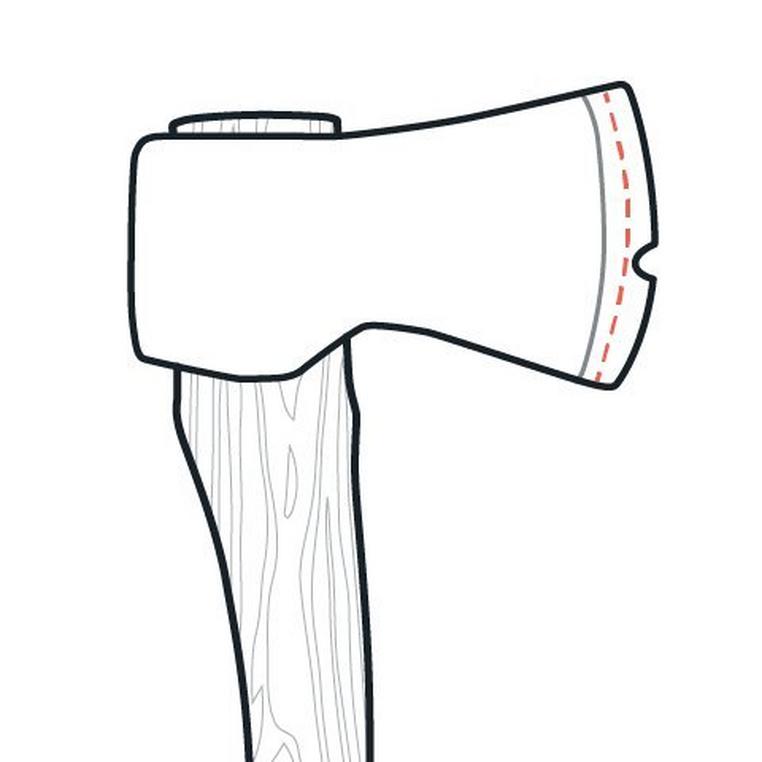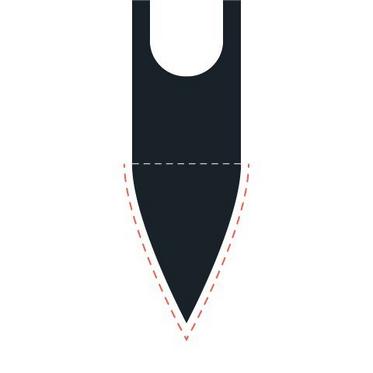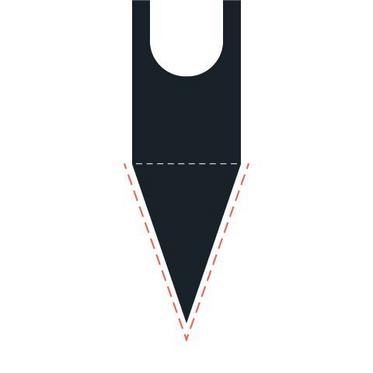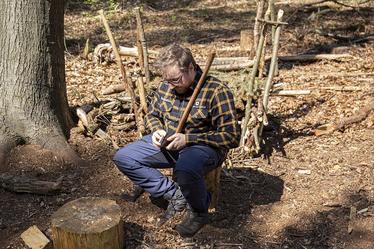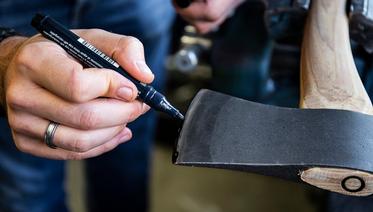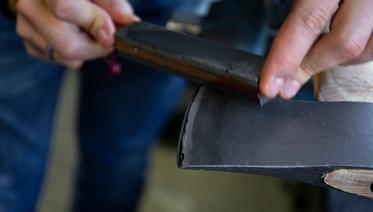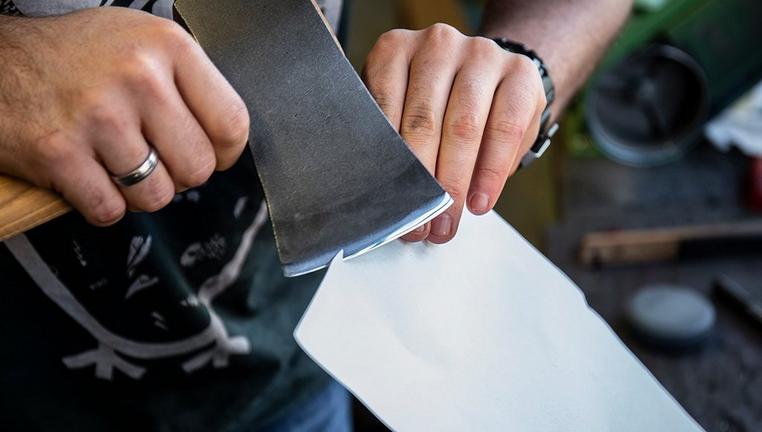How do you sharpen an axe?
What is the best way to sharpen an axe? A good question we love to answer. After all, we know a thing or two about sharpening axes and can therefore help you out!
A blunt axe is dangerous. You will notice that you apply more force, make uncontrolled movements and we don’t have to explain what the consequences could be. With a razor-sharp axe you won’t slip and will be able to chop based on technique and not brute force. A lot safer and less exhausting!
In addition to maintaining the handle it is also important to make sure the edge stays sharp. We mostly use sharpening stones when sharpening axes. In this article we tell you how to sharpen a damaged or blunt axe, how to sharpen an axe that is still in great shape and, of course, tell you all about the right posture when sharpening an axe.
Sharpening Video
Padraig Croke from the Trial by Fire podcast, thoroughly explains how to sharpen an axe in the following video:
Coarse sharpening
When we say coarse sharpening we mean repairing a damaged edge. Does the edge contain cuts? If so it fits in the 'coarse sharpening' category. To sharpen your axe you need a file or coarse (diamond-coated) sharpening stone. The coarser the grain the coarser the stone, the more material the stone removes. Do not use a grinding wheel because it can heat up the steel to such an extent it can affect the hardness of the steel. A diamond-coated sharpening stone removes more material than a ceramic sharpening stone and is therefore great when repairing a damaged axe. But do you need to sharpen a damaged axe?
Is the edge chipped? Don't worry, you don't immediately have to get rid of the axe. You can sharpen the chip out or just leave it as is. If you leave it the chip will slowly wear out as you use and sharpen the axe. You can also remove the chip with an (extra)coarse diamond-coated sharpening stone. Do, however, keep in mind that you remove quite a lot of material when you do!
Fine sharpening
When we say 'fine sharpening' we mean sharpening a relatively sharp or undamaged edge. There are two grinds often used on axes. A convex or a scandi grind. A convex edge can handle quite a lot because there is more mass directly behind the edge. Sharpening, however, takes some getting used to because you don't use a fixed angle.
An axe with a scandi grind is sharper, but less strong. As such this grind is more suited for carving or hand axes. Sharpening a scandi edge is easier because you use a fixed angle.
Sharpness of axes
The edge of a splitting axe is straight and undamaged but doesn't have to be sharp. A felling axe needs to be sharp to be functional. A trekking axe needs to be very sharp to remove a lot of material. A carving axe needs to be razor-sharp.
Maintenance axe head
The head of the axe doesn't require a lot of maintenance. Properly dry the head after use. Fresh wood is wet and oak wood, for instance, also contains tannic acids. As such you will not only be bothered by rust but also by other nasty spots on the head of the axe. Fortunately, as long as you make sure the axe is dry as you store it you don't have to worry about this. If you find spots on the edge or the rest of the head don't use a sharpening stone. It will leave behind nasty scratches and cannot reach the difficult-to-reach places. Always use Naniwa rust eraser to remove these spots.
Posture and technique
The right posture when sharpening is different for everyone. Also, different sharpening methods ask for different postures. With the KME Axe Sharpener, for instance, it is best if you lay the axe flat on your thighs. Sharpen an axe by hand is easiest if you hold the head in your hand and let the handle rest in your neck. As such you can easily see which angle you are using. You can do this both when standing and when seated. The sharpening angle for an axe is approximately 30 degrees per side.
It works best if you make rotating movements with the sharpening stone, like you are cleaning it. Try to keep the movement as small as possible, to make sure you sharpen the entire edge. As such you also make sure the stone doesn't slip from your hand. Do this until you feel a burr. When you do you switch to the other side of the axe.
To determine if you sharpen the entire edge (and use the right angle), you can also use a marker to mark the edge. Still see some marker after sharpening the edge? This means that this part hasn't come into contact with the sharpening stone. Adjust the angle and sharpen again to make sure you also sharpen this part of the edge.
Posture and technique
Do you prefer to sharpen your axe at home? No problem at all! Another option to sharpen your axe is to secure it in a vise. Because the axe is nicely secured you can use both hands to sharpen the axe. As such you can maintain the right sharpening angle and easily guide the axe. There are a couple of techniques to make sure you don't cut yourself but we strongly recommend using working gloves as you start sharpening your axe.
Sharpening stones
When sharpening an axe we recommend smaller sharpening stones. Because you make small round movements and a small sharpening stone is a lot lighter. Below a number of options to sharpen your axe.
Stropping your axe
Finally you could use a leather stropping belt. Attach it to one side by securing it in the vice, for instance and hold tight to the other side, after which you move the axe over the belt ‘away from the edge’. If you would move the razor-sharp edge towards the belt you will immediately cut through it. As such you remove the last imperfections which you won’t be able to see but are still there.
Sharpness test
To make sure the edge of your axe is sharp enough you can carefully place the edge on the nail of your thumb at a 45-degree angle. If the axe slides off it is not sharp enough. You can also try cutting a piece of paper with the axe to see if it is sharp.
Tip:
What else do you take with you as you embark upon a new adventure with your axe and sharpening stone? Yes! A first-aid kit!
# Electric sharpening machines
There are, of course, multiple other ways to sharpen your axe. Several sharpening belt machines are perfect for sharpening axes. Take, for instance, the Work Sharp Multi sharpener Ken Onion Edition and the Work Sharp Knife & Tool Sharpener. The Ken Onion Edition comes with sharpening belts with grain sizes 120, 220, 1000, 3000 and 6000. As a result you can first remove any imperfections from the blade of the axe and restore the fold, after which you use the other belts to make the edge razor-sharp again. With it you can vary between a 15 degree and a 30 degree angle (and all sizes in between). Perfect, considering the fact you often use a 30 degree angle for axes.
The Knife & Tool Sharpener has three different sharpening belts: grain 80, 220 and 6000. Slightly fewer choices but perfect for extremely blunt edges, thanks to the grain 80 belt. The angle can be determined at 20, 25 and 65 degrees. As such it is a little less suited to sharpen axes than the Ken Onion version.
Want to learn more about sharpening in general? Or are you curious to find out how you sharpen chisels or scissors? Read all about it in our info-topics.
